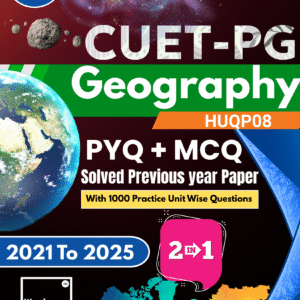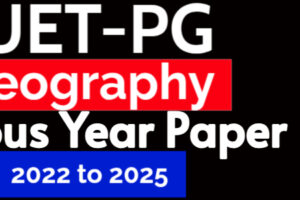
CUET-PG Geography [HUQP08] Exam 2026 Syllabus II Books II Particapted Universities II Seats in DU II Cut-off II Previous Year Paper II Exam Pattern & Career Scope II Eligibility Criteria
The CUET-PG Geography [HUQP08] 2026 examination is a gateway for aspiring postgraduate students to secure admission in some of India’s top central and participating universities, including the prestigious University of Delhi (DU). Designed to assess a candidate’s knowledge, aptitude, and analytical skills in Geography, this national-level entrance test is conducted by the National Testing Agency (NTA).This article provides a comprehensive guide to the CUET-PG Geography exam, including its detailed syllabus, recommended books, exam pattern, previous year question papers, and career prospects after postgraduation. Additionally, it covers vital information on participating universities, DU seat matrix, cut-off trends, and the eligibility criteria to help students plan their preparation effectively and make informed academic decisions. Whether you are a first-time aspirant or looking to understand the academic and professional scope of a postgraduate degree in Geography, this guide aims to offer all essential insights under one roof.
Table of Contents
Here’s a concise Exam Overview Table for CUET-PG Geography Exam 2026:
| Feature | Details |
|---|---|
| Exam Name | CUET-PG Geography 2026 |
| Full Form | Common University Entrance Test – Postgraduate (Commerce) |
| Conducting Authority | National Testing Agency (NTA) |
| Exam Level | National Level |
| Mode of Exam | Computer-Based Test (CBT) |
| Medium of Exam | English & Hindi (in most cases) |
| Duration | 105 minutes (1 hour 45 minutes) |
| Total Questions | 75 Questions |
| Total Marks | 300 Marks |
| Question Type | Multiple Choice Questions (MCQs) |
| Marking Scheme | +4 for correct answer, -1 for incorrect answer |
| Eligibility | Bachelor’s Degree in Commerce or equivalent (minimum 50% marks typically) |
| Frequency of Exam | Once a year |
| Official Website | https://pgcuet.samarth.ac.in |
CUET -PG Geography [HUQP08] Latest Syllabus 2026 [Chapter /Section] –
Here is the complete syllabus for Geography (HUQP08) presented in a structured table format:
| Part | Section | Topics |
|---|---|---|
| PART-A: PHYSICAL GEOGRAPHY | Section I: Geomorphology | Solar system and the Earth – Origin of the earth: important theories – Earth’s interior – Geological time scale – Earth’s Materials and minerals – Rocks classification and characteristics – Earth surface configuration – Order of landforms – Wegner’s theory – Plate tectonics. Endogenic processes: Folds, Fault, Dome and their resultant landforms – Earthquakes and Volcanic activities: causes, resultant landforms and world distribution. Exogenic processes: Weathering, Mass wasting and resultant landforms – Formation of regolith and soil – Geomorphic agents and processes: Fluvial, Glacial, Coastal, Arid and Karst landforms – Geomorphic hazards and their effects. |
| Section II: Climatology | Elements of weather and climate – Composition and Structure of the Atmosphere – Heat budget. Atmospheric pressure: Vertical and horizontal distribution – Winds and their causes of circulation – Types of planetary, Periodic and local winds – Temperature: factors and distribution – Temperature inversion. Atmosphere moisture: Humidity, evaporation and condensation – Hydrological cycle – Types, regional and seasonal distribution – Monsoon. Air masses and Fronts – Atmospheric disturbances: Tropical and Temperate cyclones – Anti-cyclones – El-Nino-Southern Oscillation (ENSO) – Recent climatic variability phenomenon. Climatic classification – Basis of Koppen’s and Thornthwaite’s classification – Role of climate in Human life – Atmospheric pollution and global warming: general causes and consequences. | |
| Section III: Oceanography | Surface configuration of the ocean floor – Hypsographic curve: continental shelf, continental slope, abyssal plain, trenches and deeps – Relief of Atlantic, Pacific, and Indian Oceans. Distribution of temperature and salinity of oceans and seas – Circulation of oceanic waters, waves and currents – Currents of Atlantic, Pacific and Indian oceans – Tides: causes, types and theories. Marine deposits – Coral reefs: types and their formation – Coastal environment – Ocean as store house of resources for the future. | |
| Section IV: Biogeography | Biosphere: Meaning and concept – Components of ecosystem and ecology – Biomes: World major biomes and their characteristics. Functions: Trophic levels, energy flows, cycles (geo-chemical, carbon, nitrogen and oxygen), food chain, food web and ecological pyramid. Human interaction and impacts – Environmental ethics – Environmental hazards and disasters (global warming, urban heat island, atmospheric pollution, water pollution, land degradation). Environmental policies – Environmental impact assessment. | |
| Section V: Physical Geography of India | Land of diversities – Geological structure – Physical features and divisions – Drainage pattern – Soil types and distribution – Natural vegetation. Climate: Seasons – Monsoon (origin, regional and seasonal variations) – Distribution of temperature and rainfall – Local winds. Mineral and power resources: Major types and their potential, distribution and production – Sources of non-conventional energy. | |
| PART-B: HUMAN GEOGRAPHY | Section VI: Geographic Thought | Nature and scope of geography – A brief historical overview of geography as a discipline – Branches of geography: general characteristics and inter-relationships. Contributions of Greek, Roman, Arab, Chinese and Indian Scholars – Contributors for the development of modern geography – Recent Trends in Geography. Dualisms in geographic studies (physical vs. human, regional vs. systematic, qualitative vs. quantitative, ideographic vs. nomothetic) – Paradigm shift – Perspectives in geography (positivism, behaviouralism, humanism, structuralism, feminism and postmodernism). |
| Section VII: Population Geography | Division of mankind – Racial groups and culture: systems, characteristics and distribution – Human Adaptation to the environment – Adaptation in modern society – Globalization and cultural change – Language, communication and belief. Distribution and density of population: Factors, growth and distribution – Population composition – Population theories – Health and wellbeing. Migration: Internal and international – Settlements: rural and urban – Urbanization process – Patterns and world distribution – Population policies. Electoral geography – Frontiers and Boundaries – Geopolitics and world order – Geopolitical conflicts. | |
| Section VIII: Geography of Resources | Nature and components of resources – Resources and environment interface – Classification of resources: renewable and non-renewable, biotic and abiotic resources. Water, forests and soil resources: Types, distribution, economic and environmental significance – problems of deforestation, soil erosion and water pollution. Exploitation of natural resources – Impact of Human activities: deforestation, mining, agriculture and industrialization on environment – Population pressure and resources utilization – Population explosion and food security – Environmental hazards: pollution and its related problems – Emerging environmental problems – Global warming – Environmental conservation, preservation, and sustainable resource use. | |
| Section IX: Economic Geography | Sectors of economic activity: Primary, Secondary and Tertiary – Favourable geographical conditions for different economic activities. Agriculture: Primary crops (wheat, rice and maize), commercial crops (cotton, sugarcane, tea, coffee, rubber) distribution and production – Livestock and Fisheries – Important fishing grounds. Mining economy: Factors governing the exploitation of minerals – World reserves and production of Iron ore, Manganese, Bauxite and Copper. Fuel and power resources of the world – Distribution and production of coal, petroleum, hydroelectric power, atomic energy and non-conventional sources of energy. Manufacturing industries: Factors affecting location – growth and distribution of major industries – World production and distribution. Nature and trends in the International trade – World trade of wheat, cotton, tea, coffee, petroleum, gold, silver, gems and jewelry. Transport: Relative significance of different means of transport – Factors affecting land, water and air transport – World oceanic routes – Important inland waterways and important canals – Impact of globalization on world economy. | |
| Section X: Human Geography of India | Cultural landscape: Population growth, distribution and density – Population composition – Settlements and Urbanization. Agriculture: Major crops, impact of green revolution, Regionalization of Indian agriculture. Industrial development – Location and distribution of iron and steel, cement, cotton textile and sugar industry – Industrial Regions and their characteristics – Industrial Policies in India. Transport Networks (railways, roadways, waterways, airways and pipelines) – International Internal and External Trade (trend, composition and directions). Regional development planning in India – Globalisation and its impact on Indian Economy – Changing nature of Indian economy – Socio-economic development – Impact of development on environment and natural resources. | |
| PART-C: GEOGRAPHICAL TECHNIQUES | Section XI: Cartography | Elements of Map Science – Concepts of scale and map – Types of maps and scales – Construction of graphic/linear scales – Enlargement and reduction of maps: methods and procedures – Map compilation and generalization. General principles and classification of projections: construction, properties, limitations and uses of Zenithal, Conical and Cylindrical projections. Methods of showing relief (hachure, shading, and contours) – Contour interpolation – Profiles: drawing of profiles and their relevance in landforms mapping and analysis – Identification of different rocks – SOI Toposheets – Interpretation of physical and cultural topographic sheets. Methods and instruments for collection of weather data – Construction of climograph and hythergraph, isotherm, isobars and isohyets – Preparation of weather maps – Symbols used in weather maps – Interpretation of Indian daily weather maps. Mapping techniques of population, social, economic and cultural data – dot, isopleth, anchoropleth methods. |
| Section XII: Surveying Techniques | Basic principles of surveying – Types of surveying – Surveying instruments – Basic principles of field work – Techniques in physical and socio-economic field surveys – Data collection methods. Chain and tape survey – Prismatic compass survey – Plane Table survey – Levelling techniques – Electronic surveying instruments (Theodolite and electronic devices). | |
| Section XIII: Statistical Techniques | Statistical Methods: Frequency distribution and histograms – Measures of central tendency and dispersion – Diagrammatic representation of geographical and statistical data. Sampling Techniques – Tests of significance – Probability distributions: normal, binominal and Poisson – parametric and non-parametric tests – Correlation and regression. | |
| Section XIV: Remote Sensing and GIS | Remote sensing principles – Types of remote sensing – Aerial photography – Satellite images – Application of Remote Sensing Techniques. Components and function of GIS – Spatial and non-spatial data – Vector and raster format – GIS analysis – Application of GIS. Basic principles of Global Navigation Satellite System – Segments and applications. |
CUET-PG Geography 2026 – Consolidated Chapter-wise Important Topics Table
| Unit No. | Chapter/Topic Title | Key Subtopics / Important Areas |
|---|---|---|
| 1 | Nature & Scope of Human Geography | Definition, evolution, branches, approaches (determinism vs possibilism), spatial analysis |
| 2 | Population: Distribution & Composition | Density, growth trends, sex ratio, literacy, rural-urban patterns, population pyramids |
| 3 | Human Development | HDI indicators, global comparisons, health, education, gender inequality |
| 4 | Economic Activities | Primary (agriculture, fishing, forestry), Secondary (industries), Tertiary (services), Quaternary (R&D) |
| 5 | Transport & Communication | Modes of transport (land, water, air), ICT, international trade routes, globalization impacts |
| 6 | Human Settlements | Rural vs urban, morphology, classification (nucleated, dispersed), functional types |
| 7 | Indian Population & Migration | Distribution, linguistic & religious composition, tribal population, inter/intra migration patterns |
| 8 | Settlements in India | Growth of towns, smart cities, slums, census town-vs-statutory town |
| 9 | Indian Resources & Development | Land use types, irrigation types, agriculture patterns, minerals (iron, coal), energy (renewables vs non-renewables) |
| 10 | Water Resources in India | River basins, water sharing disputes, watershed development, conservation efforts |
| 11 | Transport & Trade in India | Railways, highways, ports (Kandla, Mumbai), air connectivity, international trade commodities |
| 12 | Environmental Issues | Land degradation, deforestation, waste management, urban floods, climate change implications |
| 13 | Statistical Techniques in Geography | Mean, median, mode, standard deviation, correlation, regression, chi-square, significance testing |
| 14 | Remote Sensing & GIS | Aerial photography, satellite imagery, raster/vector data, map overlay, GPS/GIS applications in planning |
📊 CUET-PG Geography (HUQP08) Section-wise Question Distribution (2021–2025)
| Section | No. of Questions (Approx.) |
|---|---|
| I | 37 |
| II | 36 |
| III | 24 |
| IV | 29 |
| V | 20 |
| VI | 32 |
| VII | 40 |
| VIII | 5 |
| IX | 29 |
| X | 31 |
| XI | 34 |
| XII | 14 |
| XIII | 22 |
| XIV | 22 |
Section-wise Book Recommendations for CUET PG Geography (HUQP08)
| Section | Recommended Books | Authors/Publications |
|---|---|---|
| Section I: Geomorphology | – Physical Geography – Geomorphology – Certificate Physical and Human Geography | Savindra Singh Kale & Gupta Goh Cheng Leong |
| Section II: Climatology | – Climatology – Atmosphere, Weather and Climate – Physical Geography | D.S. Lal Roger G. Barry & Richard J. Chorley Savindra Singh |
| Section III: Oceanography | – Oceanography – Physical Geography – Fundamentals of Oceanography | Sharma & Vatal Savindra Singh Alison Duxbury |
| Section IV: Biogeography | – Biogeography – Environmental Geography – Ecology & Environment | Savindra Singh R.C. Chandna P.D. Sharma |
| Section V: Physical Geography of India | – India: A Comprehensive Geography – Geography of India | D.R. Khullar Majid Husain |
| Section VI: Geographic Thought | – Geographical Thought – Evolution of Geographical Thought | R.D. Dixit Majid Husain |
| Section VII: Population Geography | – Population Geography – Human Geography | R.C. Chandna Majid Husain |
| Section VIII: Geography of Resources | – Resource Geography – Environmental Geography | Hussain Savindra Singh |
| Section IX: Economic Geography | – Economic Geography – Agricultural Geography | R.C. Chandna Hussain |
| Section X: Human Geography of India | – India: People and Economy (NCERT Class 12) – Social Geography | NCERT R.C. Chandna |
| Section XI: Cartography | – Map Work and Practical Geography – Cartography | R.L. Singh Misra & Ramesh |
| Section XII: Surveying Techniques | – Surveying & Levelling – Practical Geography | T.P. Kanetkar R.L. Singh |
| Section XIII: Statistical Techniques | – Statistical Methods in Geography – Quantitative Techniques in Geography | R. Hammond & P. McCullagh G. Gregory |
| Section XIV: Remote Sensing & GIS | – Remote Sensing & GIS – Basics of Geoinformatics | B. Bhatta P. K. Garg |
Recommended Book
-
CUET-PG Geography [HUQP08] Solved Previous year Paper 2021 to 2025 With 1000 Practice MCQ Chapter/Section Wise With Detail Solution
Original price was: ₹800.00.₹450.00Current price is: ₹450.00.
CUET PG Geography Exam Level (2022-2025)
| Year | Difficulty | Key Trends | High-Weightage Topics | Challenging Areas |
|---|---|---|---|---|
| 2022 | Moderate | Balanced questions, factual focus | Geomorphology, Climatology | Cartography, GIS |
| 2023 | Moderate-Tough | More applied questions | Population, Economic Geography | Remote Sensing, Case Studies |
| 2024 | Tough | Balanced questions, factual focus | Indian Geography, Climate Change | Statistical Techniques, Plate Tectonics |
| 2025 | Moderate-Tough | More applied questions | GIS/Remote Sensing, Urbanization | Interdisciplinary Links |
🎓 Participating Universities Offering Geography via CUET‑PG
| University | Program | Eligibility Criteria |
|---|---|---|
| Central University of Haryana (CUHAR) | M.Sc Geography | Bachelor’s degree (any discipline), ≥ 50% (45% for SC/ST/OBC/PWD) |
| Central University of Jammu (CUJAM) | M.Sc Geography | Same as CUHAR (CUET‑PG 2026 list) |
| Central University of Punjab (CUPUN) | M.Sc Geography | Same general criteria |
| Central University of South Bihar (CUSBR) | M.Sc Geography | Same general criteria; seats ~1460+ across PG |
| Central University of Tamil Nadu (CUTND) | M.Sc Geography | Same general criteria |
| University of Delhi (DU) | MA/MSc Geography | Bachelor’s in Geography (or related), ≥ 50% marks |
| Jawaharlal Nehru University (JNU) | M.Sc Geography | Bachelor’s degree, ≥ 50%; selection via CUET‑PG & entrance/merit |
| Banaras Hindu University (BHU) | M.Sc Geography | Graduate (any discipline), ≥ 50% + PET (or CUET‑PG) |
| Sikkim University | MA/MSc Geography | Bachelor’s degree with ≥ 50%, CUET‑PG entrance |
| Gauhati University | MA Geography | Bachelor’s degree; no specific CUET‑PG but PG via GUPGET; ~40 seats |
| Cotton University | M.A/M.Sc Geography | Bachelor’s degree (any discipline), CUET‑PG accepted; ~30 geography seats |
🎓 Seat Matrix for MA/MSc Geography in Central Universities
| University | Program | Seats Available |
|---|---|---|
| Central University of Haryana | MSc Geography | 40 |
| Central University of Jammu | MSc Geography (or integrated) | 30–45 (incl. integrated UG–PG) |
| Central University of Karnataka | MSc Geography | 30 |
| Central University of Punjab (Bathinda) | MA/MSc Geography | 40 |
| Central University of Jharkhand (Ranchi) | MSc Geography | 31 |
| Central University of South Bihar (Patna) | MSc Geography | 45 |
| Gauhati University | MA Geography | 40 |
| Cotton University (Guwahati) | MSc Geography | 30 |
🎓 Seat Matrix for MA/MSc Geography – Category-wise (2025)
1. University of Delhi (MA Geography)
(Total seats: 96) Approx
| Category | Seats (Entrance) | Seats (Merit) | Total |
|---|---|---|---|
| UR | 19 | 19 | 38 |
| OBC (27%) | 13 | 13 | 26 |
| SC (15%) | 7 | 7 | 14 |
| ST (7.5%) | 4 | 4 | 8 |
| EWS (10%) | 5 | 5 | 10 |
| Total | 48 | 48 | 96 |
2. Banaras Hindu University (M.Sc. Geography)
(Total seats: 81) Approx
| Category | Seats |
|---|---|
| General | – |
| OBC | – |
| SC | – |
| ST | – |
| PwD / Others | – |
| Total | 81 |
(BHU follows standard reservation: 27% OBC, 15% SC, 7.5% ST, plus 10% EWS & PwD)
✅ Summary Table
| Institution | Total Seats | UR | OBC | SC | ST | EWS | PwD & Others |
|---|---|---|---|---|---|---|---|
| DU (MA) | 96 | 38 | 26 | 14 | 8 | 10 | Supernumerary |
| BHU (MSc) | 81 | – | – | – | – | – | Included |
| CUSB / CUH / CUJ etc. | ~30–45 | Based on standard reservation policy | Based on the standard reservation policy |
CUET PG Geography (HUQP08) Exam Pattern 2026
| Aspect | Details |
|---|---|
| Exam Mode | Computer-Based Test (CBT) |
| Duration | 105 minutes (1 hour 45 mins) |
| Total Questions | 75 (All compulsory) |
| Question Type | MCQs (Multiple Choice Questions) |
| Language Medium | Bilingual (English & Hindi) |
| Marking Scheme | +4 for correct answer, -1 for incorrect answer |
| Syllabus Coverage | 3 Parts (A, B, C) with 14 Sections (as per syllabus) |
🌍 Career Opportunities After M.A. Geography
| Career Sector | Job Roles | Additional Requirements / Notes |
|---|---|---|
| Academics & Research | Assistant Professor, Research Scholar, Project Fellow | UGC-NET/JRF, Ph.D. for long-term teaching/research |
| Government Services | IAS, IPS, IFS, State PCS Officer, Assistant Town Planner | Geography optional is widely preferred in UPSC/State PCS |
| GIS & Remote Sensing | GIS Analyst, Remote Sensing Specialist, Cartographer | GIS/RS certifications (e.g., NIPGR, ISRO-IIRS, ESRI) |
| Urban Planning | Urban Planner, Regional Development Analyst | Useful to pursue M.Tech in Urban/Regional Planning (via GATE) |
| Environmental Sector | Environmental Consultant, Disaster Analyst, Sustainability Officer | Roles in NDMA, NIDM, UNEP, TERI, WWF |
| International Organizations | Climate Change Analyst, Geospatial Consultant, Program Associate | Opportunities in UNDP, World Bank, ICIMOD |
| Private Sector & Industry | Market Researcher, Logistics Analyst, Location Expert (Retail/Telecom) | Use of GIS in supply chain, logistics, and retail planning |
| Media & EdTech | Content Developer, Geography Educator, Competitive Exam Trainer | Roles in Byju’s, Unacademy, Testbook, YouTube |
| Defense & Intelligence | Geo-intelligence Analyst, Remote Sensing Expert for Defense Mapping | Work in DRDO, ISRO, or Defense GIS Labs |
| Further Studies | Ph.D. in Geography, Urban Studies, Environmental Science | Strong base in theory + tools like GIS/RS helpful |
💼 Salary Structure After M.A. Geography
| Career Path | Job Roles | Average Starting Salary (INR/month) | Salary After Experience (5+ yrs) |
|---|---|---|---|
| Academia | Assistant Professor, Lecturer | ₹40,000 – ₹60,000 | ₹80,000 – ₹1.2 Lakh+ (after PhD, promotions) |
| Research & Fellowships | JRF, SRF, Project Fellow | ₹31,000 – ₹35,000 (JRF) | ₹40,000 – ₹50,000 (SRF/Postdoc) |
| Government Services (UPSC/PCS) | IAS, IFS, SDM, Tehsildar | ₹56,100 – ₹1,77,500 (Pay Level 10–13) | ₹2 Lakh+ with perks (Cabinet Secretary level) |
| GIS & Remote Sensing | GIS Analyst, Cartographer, RS Specialist | ₹25,000 – ₹45,000 | ₹60,000 – ₹1 Lakh+ |
| Urban & Regional Planning | Town Planner, Municipal Analyst | ₹40,000 – ₹70,000 | ₹1 Lakh+ in govt/private consultancy firms |
| Environmental Sector | Environmental Officer, Climate Analyst | ₹30,000 – ₹50,000 | ₹70,000 – ₹1.2 Lakh |
| Private Sector & Industry | Location Planner, Market Analyst | ₹25,000 – ₹50,000 | ₹70,000+ in MNCs |
| EdTech & Content Writing | Subject Expert, Content Developer | ₹20,000 – ₹45,000 | ₹60,000 – ₹80,000+ with seniority |
| International Agencies | UNDP/ICIMOD Program Officer, GIS Consultant | ₹60,000 – ₹1.5 Lakh+ | ₹2 Lakh+ (depending on role/project funding) |
| Defense & Mapping (DRDO/ISRO) | Geo-intelligence Expert, Remote Sensing Analyst | ₹40,000 – ₹60,000 | ₹80,000 – ₹1.3 Lakh |
CUET PG 2025 Counselling Timeline
| Event | Tentative Dates |
|---|---|
| CUET PG Result Declaration | May 6, 2025 |
| Counselling Registration Start | June 2025 |
| Document Verification | June – July 2025 |
| Seat Allotment Rounds | July 2025 |
| Commencement of Classes | August 2025 |
Note: Specific dates may vary by university. Always check the official website of each institution for accurate timelines.
🧭 Step-by-Step Counselling Process
- Check Eligibility & Cut-offs: After results are declared, universities release their course-wise cut-off marks. Ensure you meet these criteria before applying.
- Register Online: Visit the official website of each university you’re interested in and complete the counselling registration. This typically involves:
- Filling in personal and academic details
- Uploading necessary documents
- Paying a registration fee (amount varies by university)
- Choice Filling: Select your preferred courses and campuses in order of priority. Ensure you review and lock your choices before the deadline.
- Document Verification: Universities will verify the authenticity of your submitted documents. This may be done online or in person, depending on the institution’s process.
- Seat Allotment: Based on your CUET PG score, category, and preferences, universities will allot seats. Results are typically published on the respective university’s portal.
- Acceptance & Fee Payment: If allotted a seat, confirm your acceptance by paying the admission fee within the stipulated time. Failure to do so may result in forfeiture of the seat.
- Subsequent Rounds & Spot Counselling: If seats remain vacant, universities may conduct additional rounds or spot counselling. Stay updated with each university’s announcements.
📄 Documents Required
Ensure you have both the original and photocopies of the following:
- CUET PG 2025 Scorecard
- CUET PG 2025 Admit Card
- Class 10th & 12th Mark Sheets and Certificates
- Bachelor’s Degree Mark Sheets and Certificate
- Transfer Certificate (TC)
- Migration Certificate (if applicable)
- Caste/Category Certificate (if applicable)
- Domicile Certificate (if required by the university)
- Income Certificate (for scholarship considerations)
- Passport-sized Photographs
- Valid ID Proof (Aadhar Card, Voter ID, or PAN Card)
CUET-PG Geography Previous Year Papers 2021 to 2024
| Year | Availability | Download Link |
|---|---|---|
| 2024 | ✅ Available | Download PDF |
| 2023 | ✅ Available | Download PDF |
| 2022 | ✅ Available | Download PDF |
| 2021 | ✅ Available | Download PDF |
📘 CUET PG Geography (HUQP08) – Frequently Asked Questions
| Question | Answer |
|---|---|
| 1. What is HUQP08 in CUET PG? | HUQP08 is the subject code for Geography in CUET PG, used for applying to M.A./M.Sc. Geography programs across participating universities. |
| 2. Who is eligible to apply for CUET PG Geography? | Candidates must have a Bachelor’s degree in Geography or related disciplines (e.g., Environmental Science, Geology) with a minimum of 50–55%. |
| 3. What is the exam pattern for HUQP08? | The exam comprises 100 MCQs, with each question carrying 4 marks (total: 400). There is -1 negative marking for incorrect answers. |
| 4. How many questions are asked from each section? | The blueprint shows variable section-wise questions (e.g., Climatology: 37, Geomorphology: 36, etc. from past years 2021–2025). |
| 5. What are the important topics in the syllabus? | Key units include Geomorphology, Climatology, Oceanography, Population & Settlement Geography, Economic Geography, Remote Sensing, GIS, etc. |
| 6. Which universities offer M.A./M.Sc. Geography via CUET PG? | Major CUs: Delhi University, BHU, JNU, Central University of Punjab, CUSB, CUJ, HNBGU, and many more. |
| 7. What is the cut-off score for DU/BHU/JNU Geography? | General category cut-offs are typically 230–250/400, with l |



